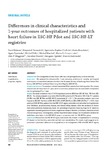Mostrar o rexistro simple do ítem
Differences in clinical characteristics and 1-year outcomes of hospitalized patients with heart failure in ESC-HF Pilot and ESC-HF-LT registries
| dc.contributor.author | Balsam, Pawel | |
| dc.contributor.author | Ozieranski, Krzysztof | |
| dc.contributor.author | Kaplon-Cieslicka, Agnieszka | |
| dc.contributor.author | Borodzicz, Sonia | |
| dc.contributor.author | Tyminska, Agata | |
| dc.contributor.author | Peller, Michal | |
| dc.contributor.author | Marchel, Michal | |
| dc.contributor.author | Crespo-Leiro, María Generosa | |
| dc.contributor.author | Maggioni, Aldo P. | |
| dc.contributor.author | Drozdz, Jaroslaw | |
| dc.contributor.author | Opolski, Grzegorz | |
| dc.contributor.author | Grabowski, Marcin | |
| dc.date.accessioned | 2019-03-12T11:35:09Z | |
| dc.date.available | 2019-03-12T11:35:09Z | |
| dc.date.issued | 2019-01-16 | |
| dc.identifier.citation | Balsam P, Ozieranski K, Kaplon-Cieslicka A, et al. Differences in clinical characteristics and 1-year outcomes of hospitalized patients with heart failure in ESC-HF Pilot and ESC-HF-LT registries. Pol Arch Intern Med. 2019; 129(2): 902-912 | es_ES |
| dc.identifier.issn | 0032-3772 | |
| dc.identifier.uri | http://hdl.handle.net/2183/22179 | |
| dc.description.abstract | [Abstract] INTRODUCTION The management of heart failure (HF) has changed significantly in recent decades. OBJECTIVES We analyzed the clinical profile, 1‑year outcomes, predictors of mortality, and hospital readmissions in hospitalized patients enrolled in the European Society of Cardiology Heart Failure Pilot Survey (ESC‑HF Pilot) and Heart Failure Long‑Term Registry (ESC‑HF‑LT). PATIENTS AND METHODS The analysis included hospitalized Polish patients from both registries. The primary endpoint was all‑cause death at 1 year, while the secondary endpoint was all‑cause death or hospitalization for worsening HF at 1 year. RESULTS The study included a total of 1415 hospitalized patients (650 from ESC‑HF Pilot; 765 from ESC‑HF‑LT). The primary endpoint occurred in 89 of the 650 patients (13.7%) and in 120 of the 711 patients (16.9%) from ESC‑HF Pilot and ESC‑HF‑LT, respectively (P = 0.11). The secondary endpoint was more frequent in ESC‑HF Pilot than in ESC‑HF‑LT (201 of 509 [39.5%] vs 222 of 663 [33.5%]; P = 0.04). Compared with ESC‑HF Pilot, patients from the ESC‑HF‑LT registry were older and more often had hypertension, atrial fibrillation, peripheral artery disease, and chronic kidney disease, while the incidence of chronic obstructive pulmonary disease was lower. The percentage of patients receiving drugs for HF (diuretics, angiotensin‑converting enzyme inhibitors, angiotensin receptor blockers, β‑blockers, mineralocorticoid receptor antagonists), anticoagulants, cardiac resynchronization therapy, and implantable cardioverter‑defibrillator were higher in the ESC‑HF‑LT group in comparison with the ESC‑HF Pilot group. CONCLUSIONS Patients from the ESC‑HF‑LT registry had a lower risk of death or hospitalization for worsening HF despite the fact that they were older and had more comorbidities. The results might suggest an improvement in physicians’ adherence to the guidelines on the management of HF in the ESC‑HF‑LT registry. | es_ES |
| dc.language.iso | eng | es_ES |
| dc.publisher | Medycyna Praktyczna | es_ES |
| dc.relation.uri | http://dx.doi.org/10.20452/pamw.4418 | es_ES |
| dc.rights | Atribución-NoComercial-CompartirIgual 3.0 España | es_ES |
| dc.rights.uri | http://creativecommons.org/licenses/by-nc-sa/3.0/es/ | * |
| dc.subject | Heart failure | es_ES |
| dc.subject | Hospitalization | es_ES |
| dc.subject | Prognosis | es_ES |
| dc.subject | Registry | es_ES |
| dc.title | Differences in clinical characteristics and 1-year outcomes of hospitalized patients with heart failure in ESC-HF Pilot and ESC-HF-LT registries | es_ES |
| dc.type | info:eu-repo/semantics/article | es_ES |
| dc.rights.access | info:eu-repo/semantics/openAccess | es_ES |
| UDC.journalTitle | Polish Archives of Internal Medicine | es_ES |
| UDC.volume | 129 | es_ES |
| UDC.issue | 2 | es_ES |
| UDC.startPage | 902 | es_ES |
| UDC.endPage | 912 | es_ES |
Ficheiros no ítem
Este ítem aparece na(s) seguinte(s) colección(s)
-
INIBIC-ICATC - Artigos [178]






